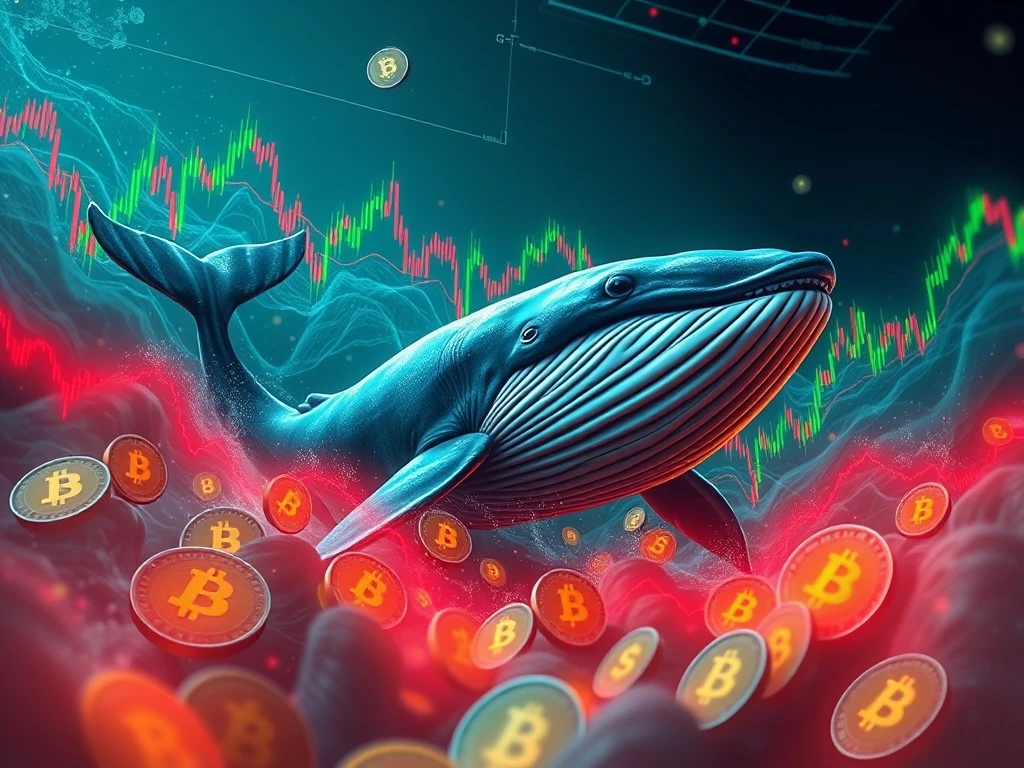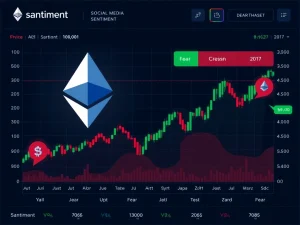Jeffrey Huang’s Audacious Bet: Doubling Down on PUMP Meme Coin Despite Staggering $10M Unrealized Losses

In the electrifying world of cryptocurrency, where fortunes are made and lost in the blink of an eye, the actions of prominent figures often draw intense scrutiny. One such figure, Jeffrey Huang, a titan in the NFT and crypto space, has recently captivated the market with his audacious crypto trading strategy involving the volatile PUMP meme coin. Despite accumulating a jaw-dropping sum in unrealized losses, Huang appears to be doubling down on his high-stakes bet, sparking widespread debate and offering critical lessons for every investor navigating the unpredictable currents of meme coin speculation.
The Enigma of Jeffrey Huang: A Whale’s Bold Crypto Trading Strategy
Jeffrey Huang, widely recognized as a significant ‘whale’ within the Bored Ape Yacht Club (BAYC) community, holds substantial influence due to his vast NFT and cryptocurrency holdings. His recent activities, however, have put his personal trading philosophy under the spotlight. On-chain data from Lookonchain on X reveals a staggering exposure to the PUMP token, highlighting the amplified risks associated with leveraged perpetual contracts.
- Spot Holdings: Huang holds $2.17 million in PUMP spot holdings.
- Perpetual Futures: An additional $8.14 million is tied up in perpetual futures contracts.
- Total Unrealized Losses: This brings his total unrealized losses to over $10 million.
Despite these mounting losses, Huang has continued to expand his long positions, a move that challenges conventional risk management and raises questions about his conviction in the asset’s future.
PUMP Meme Coin: Understanding the Volatile World of Speculative Assets
Like many of its counterparts in the meme coin universe, PUMP derives its perceived value primarily from community speculation and hype, rather than any inherent utility or fundamental technology. This characteristic makes such tokens incredibly susceptible to extreme price fluctuations.
- Extreme Volatility: Daily price swings of 50% or more are not uncommon, making them highly unpredictable.
- Liquidity Challenges: Meme coins often suffer from thin liquidity, which can exacerbate price movements and make large trades difficult without significant slippage.
- Pump-and-Dump Risks: Their speculative nature makes them prime targets for coordinated pump-and-dump schemes, where early investors inflate the price before selling off, leaving latecomers with heavy losses.
The inherent risks of the PUMP meme coin exemplify why these assets, while offering the potential for rapid gains, also carry an equally steep capacity for dramatic losses.
Jeffrey Huang Doubles Down: Conviction Versus Unrealized Losses
Huang’s decision to increase his exposure to PUMP despite substantial unrealized losses has sparked intense debate within the crypto community. Is this a display of unwavering conviction in the token’s long-term potential, or is it a classic case of the ‘sunk cost fallacy’?
- The Sunk Cost Fallacy: This psychological bias describes the tendency to continue investing in a failing endeavor because of the time, money, or effort already invested. It makes it difficult to cut losses and move on.
- Unwavering Conviction: Alternatively, Huang might possess unique insights or a strong belief that PUMP will eventually rebound, making his current losses a temporary setback before a significant upswing. This perspective often characterizes high-risk, high-reward trading.
Regardless of the underlying motivation, Huang’s actions highlight the profound psychological dynamics that influence decision-making in high-stakes crypto trading. For many, his persistence in the face of such significant losses is both bewildering and captivating.
Mastering Meme Coin Speculation: Key Lessons from a Whale’s Bet
The case study of Jeffrey Huang’s **crypto trading strategy** offers invaluable lessons for all crypto investors, particularly those venturing into the volatile realm of **meme coin speculation**.
1. The Critical Need for Robust Risk Management
Huang’s situation underscores that even seasoned investors can face substantial setbacks without proper safeguards. Implementing robust risk management strategies is paramount:
- Diversification: Never put all your eggs in one basket. Spreading investments across different assets can mitigate the impact of a single asset’s poor performance.
- Stop-Loss Mechanisms: Setting automatic stop-loss orders can help limit potential losses by selling an asset if it drops to a predetermined price.
- Position Sizing: Only allocate a small, manageable percentage of your portfolio to highly speculative assets like meme coins.
2. Beware of Psychological Biases
The emotional rollercoaster of crypto trading can cloud judgment. Be aware of common psychological pitfalls:
- Overconfidence: Believing you can outperform the market or predict unpredictable movements.
- Sunk Cost Fallacy: As seen with Huang, the reluctance to abandon a losing investment due to prior commitment.
- FOMO (Fear Of Missing Out): Rushing into investments based on hype rather than sound analysis.
3. Emphasize Due Diligence
Before investing in any cryptocurrency, especially meme coins, conduct thorough research:
- Understand the Project: Does it have a clear utility, a strong development team, and a viable roadmap? Or is it purely speculative?
- Community & Liquidity: Assess the health of the community and the trading volume/liquidity of the token.
- Market Cap & Tokenomics: Understand the supply, distribution, and market capitalization.
4. Whale Movements: A Double-Edged Sword
While tracking ‘whale’ movements like Jeffrey Huang’s can offer insights into market sentiment, smaller investors should exercise caution. Whale trades can indeed sway market sentiment, but blindly following large positions without independent research is perilous. What works for a whale with deep pockets and high risk tolerance may not be suitable for an average investor.
The Broader Impact: What Huang’s Actions Mean for the Market
Jeffrey Huang’s audacious bet on PUMP serves as a live demonstration of the high-stakes nature of meme coin markets. His actions not only influence immediate market sentiment but also contribute to the ongoing narrative about risk, reward, and responsibility in the decentralized finance space. It highlights how prominent figures can inadvertently (or intentionally) act as market movers, creating both opportunities and pitfalls for others.
As the crypto market continues to mature, stories like Huang’s will undoubtedly become cautionary tales or legendary successes, depending on the final outcome. They remind us that while crypto offers unprecedented opportunities for wealth creation, it demands a disciplined approach, continuous learning, and a healthy respect for its inherent volatility.
Conclusion: A High-Stakes Game of Conviction
Jeffrey Huang’s unwavering commitment to the PUMP meme coin, despite accumulating significant unrealized losses, is a powerful illustration of the speculative fervor that defines a segment of the crypto market. His **crypto trading strategy**, whether driven by conviction or psychological bias, serves as a poignant reminder of the extreme risks and potential rewards in this nascent industry.
For investors navigating the treacherous waters of meme coin speculation, Huang’s story is a compelling lesson. It underscores the vital importance of sound risk management, awareness of psychological traps, and diligent research. Ultimately, time will tell whether Huang’s audacious move becomes a triumphant comeback story or a stark example of overexposure to highly speculative assets. In the world of crypto, every decision is a bet, and the consequences can be truly staggering.
Frequently Asked Questions (FAQs)
Q1: What is a ‘meme coin’ and why are they so volatile?
A meme coin is a cryptocurrency that originates from an internet meme or has humorous characteristics, often lacking significant utility or fundamental technology. Their value is primarily driven by community hype, social media trends, and speculation. They are highly volatile because their prices are not tied to underlying assets or revenue, making them susceptible to rapid pump-and-dump schemes and sentiment shifts.
Q2: Who is Jeffrey Huang and why is his PUMP investment significant?
Jeffrey Huang, also known as ‘Machi Big Brother,’ is a prominent figure and ‘whale’ in the NFT and cryptocurrency space, known for his substantial holdings, particularly in Bored Ape Yacht Club (BAYC) NFTs. His PUMP investment is significant because he has accumulated over $10 million in unrealized losses yet continues to double down, highlighting the extreme risks and psychological aspects of high-stakes crypto trading.
Q3: What are ‘unrealized losses’ in crypto trading?
Unrealized losses refer to the theoretical loss on an investment that has not yet been sold. In Jeffrey Huang’s case, his PUMP tokens and futures contracts are currently worth less than his purchase price, but he has not yet sold them, meaning the losses are not ‘realized’ (locked in) until he closes his positions.
Q4: What is the ‘sunk cost fallacy’ and how does it apply to crypto?
The sunk cost fallacy is a cognitive bias where an individual continues an endeavor due to previously invested resources (time, money, effort), even if it’s clear the endeavor is failing. In crypto, it applies when investors hold onto losing assets, or even buy more, simply because they’ve already invested a significant amount, rather than cutting their losses.
Q5: What lessons can retail investors learn from Jeffrey Huang’s PUMP situation?
Retail investors can learn several crucial lessons: the importance of robust risk management (diversification, stop-losses), recognizing and avoiding psychological biases (overconfidence, FOMO, sunk cost fallacy), conducting thorough due diligence before investing, and being cautious about blindly following ‘whale’ movements without independent research.








